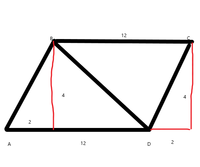You are using an out of date browser. It may not display this or other websites correctly.
You should upgrade or use an alternative browser.
You should upgrade or use an alternative browser.
Parallelogram diagonal calculation
- Thread starter arkelon19
- Start date
topsquark
Senior Member
- Joined
- Aug 27, 2012
- Messages
- 2,306
You need to show what work you've been able to do. If we know that we can help you better.
Here's a start for a). Notice that triangles ABC and CDB have both the same height and base. Thus they have the same area. What are the height and base for these triangles?
-Dan
Here's a start for a). Notice that triangles ABC and CDB have both the same height and base. Thus they have the same area. What are the height and base for these triangles?
-Dan
topsquark
Senior Member
- Joined
- Aug 27, 2012
- Messages
- 2,306
It sounds like you got a) right (it is 48) but I don't know if you are saying you got b) right?I calculated the perimeter of ABCD by using the Pythagora theorem to find CD. And for (a) I just multiplied 12 by 4.
The answer to (a) is 48 and the answer to be is 24+4√5
The following diagram will help you with c).
-Dan

pka
Elite Member
- Joined
- Jan 29, 2005
- Messages
- 11,974
The area of any parallelogram is the product of the length of its base times its height.
The length of a diagonal is the square root of the sum of the square of its base plus the square of its height.
Last edited by a moderator:
D
Deleted member 4993
Guest
I would draw the perpendicular to BC from D. Then invoking Pythagorus:
BD2 = (12-2)2 + 42
BD2 = (12-2)2 + 42

